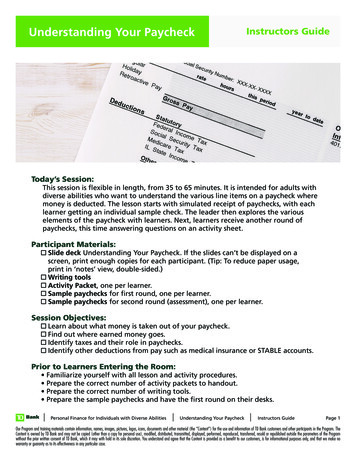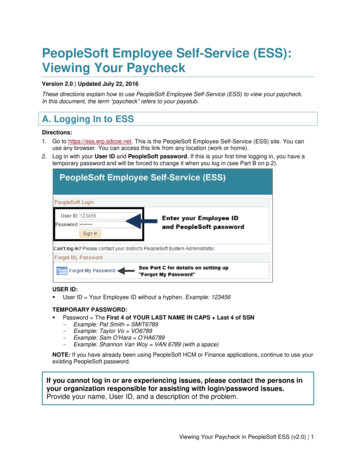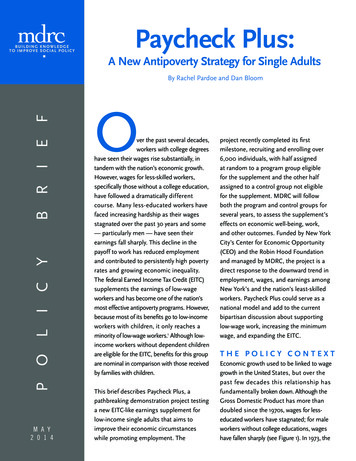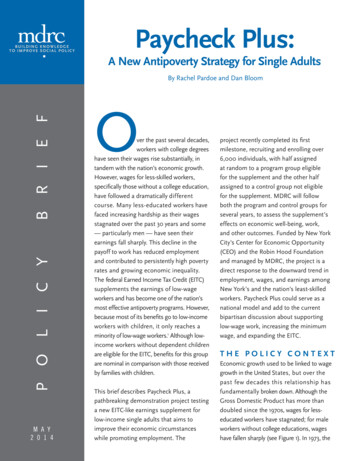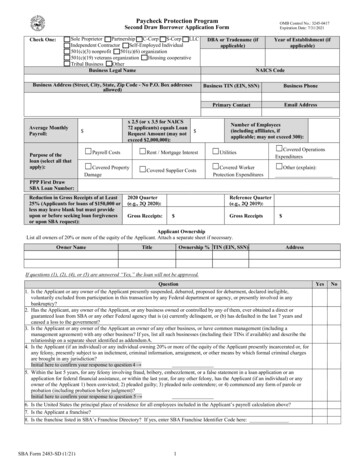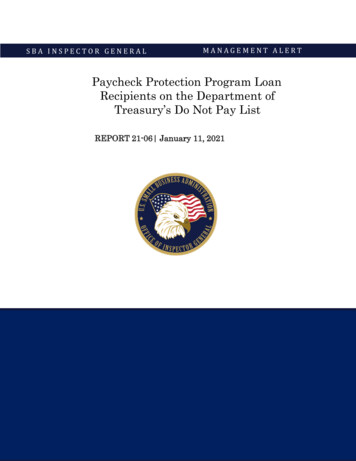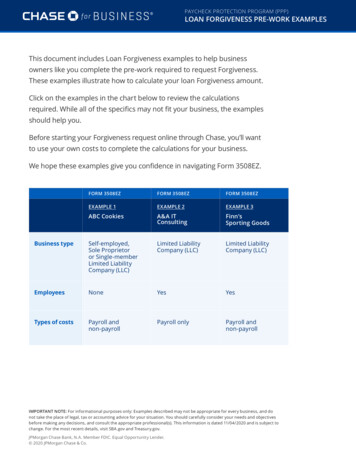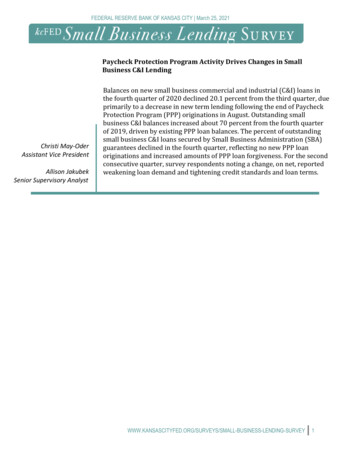
Transcription
FEDERAL RESERVE BANK OF KANSAS CITY March 25, 2021Paycheck Protection Program Activity Drives Changes in SmallBusiness C&I LendingChristi May-OderAssistant Vice PresidentAllison JakubekSenior Supervisory AnalystBalances on new small business commercial and industrial (C&I) loans inthe fourth quarter of 2020 declined 20.1 percent from the third quarter, dueprimarily to a decrease in new term lending following the end of PaycheckProtection Program (PPP) originations in August. Outstanding smallbusiness C&I balances increased about 70 percent from the fourth quarterof 2019, driven by existing PPP loan balances. The percent of outstandingsmall business C&I loans secured by Small Business Administration (SBA)guarantees declined in the fourth quarter, reflecting no new PPP loanoriginations and increased amounts of PPP loan forgiveness. For the secondconsecutive quarter, survey respondents noting a change, on net, reportedweakening loan demand and tightening credit standards and loan -LENDING-SURVEY1
FEDERAL RESERVE BANK OF KANSAS CITY March 25, 2021Chart 1: Small Business C&I Loan Balances Increase 70 Percent Year-OverYearNote: Items are calculated using a subset of 86 respondents that completed the FR 2028D for the lastfive quarters surveyed.Sources: Call Report, schedule RC-C Part I, items 4. Commercial and Industrial Loans and 12. Totalloans and leases held for investment and held for sale; and FR 2028D, items 4.b and 5.c.Small business C&I loan balances increased 69.7 percent year-over-year,bolstered by outstanding loans guaranteed by the SBA through the PPP, the thirdconsecutive quarter of year-over-year increases of nearly 70 percent. Total loansand C&I loans increased by 2.3 percent and 4.8 percent, respectively, whencompared with the same period.Despite a large year-over-year increase, small business C&I loans declined by 5.6percent quarter-over-quarter. This was primarily driven by the expiration of thePPP and an increase in loan forgiveness payments and paydowns in the fourthquarter. Total loan balances and C&I loan balances declined 1.7 percent and 4.0percent, USINESS-LENDING-SURVEY2
FEDERAL RESERVE BANK OF KANSAS CITY March 25, 2021Chart 2: Outstanding Loan Balances Secured by SBA Guarantees DeclineSource: FR 2028D, Special Question.The percentage of outstanding small business C&I loan balances secured by theSBA declined from 51 percent in the third quarter to 40 percent in the fourthquarter. This decline can be attributed primarily to the SBA’s PPP loanforgiveness, which increased in the fourth quarter, along with small businessespaying down outstanding PPP loans. Additionally, no new PPP loans wereoriginated in the fourth quarter following the close of the lending program inAugust 2020. Prior to the second quarter of 2020, the percent of balances securedby the SBA had ranged from 7 to 9 SS-LENDING-SURVEY3
FEDERAL RESERVE BANK OF KANSAS CITY March 25, 2021Chart 3: New Small Business C&I Loan Balances Decline Quarter-OverQuarter and Year-Over-YearNote: Items are calculated using a subset of 86 respondents that completed the FR 2028D for the lastfive quarters surveyed. All loan types referenced in Chart 3 refer to small business lending.Source: FR 2028D, items 7.b and 10.c.Balances on new small business C&I loans declined in the fourth quarter. Whencompared to the pre-pandemic fourth quarter of 2019, new small business C&Ilending declined by 14.2 percent, driven by a drop of 36.3 percent in new smallbusiness C&I credit line balances. New small business C&I loan balances declined20.1 percent quarter-over-quarter, reflecting the expiration of the PPP SS-LENDING-SURVEY4
FEDERAL RESERVE BANK OF KANSAS CITY March 25, 2021Chart 4: Fixed and Variable Rate Credit Line Usage DeclinesSource: FR 2028D, items 5.b and 5.c.Total small business C&I credit line usage declined for the third consecutivequarter from 40.1 percent in the first quarter to 34.0 percent in the fourthquarter. Similarly, the use of variable rate small business C&I credit lines declinedfrom 40.7 percent in the first quarter to 31.7 percent in the fourth quarter. Fixedrate small business C&I credit line usage declined for the first time since the firstquarter of 2020, declining from 52.9 percent in the third quarter to 50.5 percentin the fourth SS-LENDING-SURVEY5
FEDERAL RESERVE BANK OF KANSAS CITY March 25, 2021Chart 5: Interest Rates Remain Relatively Stable Across Most New LoanCategoriesNote: Items are calculated using a subset of 86 respondents that completed the FR 2028D for the lastfive quarters surveyed.Source: FR 2028D, items 7.c and 10.d.Weighted average rates on new fixed and variable rate lines of credit and variablerate term loans changed little in the fourth quarter. The increase of 161 basispoints in fixed rates for new term loans can be attributed, in part, to banksoriginating no new PPP loans at 1.0 percent with the August close of the INESS-LENDING-SURVEY6
FEDERAL RESERVE BANK OF KANSAS CITY March 25, 2021Chart 6: Interest Rates on Fixed Rate New Term Loans Higher than All OtherTerm Loan RatesNote: Average interest rates are weighted by the dollar volume of new small business C&I loans.Source: FR 2028D, items 4.c, 5.d, 7.c and 10.d.The weighted average rates for fixed rate new small business C&I term loanswere higher than the weighted average rates for all other term loans, primarilydue to banks originating no PPP loans after the SBA program closed in August.Weighted average variable rates on outstanding lines of credit were the highest,at 7.13 percent, while weighted average rates on outstanding fixed rate termloans were the lowest at 2.60 SS-LENDING-SURVEY7
FEDERAL RESERVE BANK OF KANSAS CITY March 25, 2021Chart 7: Percent of New Loans with Interest Rate Floor and 3-Month U.S.Treasury Rate Remain Relatively StableSource: FR 2028D, items 4.o, 5.n, 7.m, 7.o, 10.l and 10.n., Federal Reserve Bank of St. Louis FRED, 3Month Treasury Constant Maturity Rate.The percent of new small business C&I loans with interest rate floors and the 3-Month U.S.Treasury Rate remained relatively stable in the fourth quarter, with the percentage of newloans with interest rate floors declining slightly to 8.5 percent and the 3-Month U.S. TreasuryRate declining slightly to 0.09 SS-LENDING-SURVEY8
FEDERAL RESERVE BANK OF KANSAS CITY March 25, 2021Chart 8: Respondents Report Mixed Credit Line UsageNotes: Chart 8 shows diffusion indexes for credit line usage. The diffusion indexes show the differencebetween the percent of banks reporting decreased credit line usage and those reporting increasedcredit line usage. Net percent refers to the percent of banks that reported having decreased(“decreased somewhat” or “decreased substantially”) minus the percent of banks that reportedhaving increased (“increased somewhat” or “increased substantially”). 1Source: FR 2028D, items 11 and 12.The percentage of respondents indicating a change in credit line usage, whetheran increase or decrease, declined from 44 percent in the third quarter to 36percent in the fourth quarter. Responses were split nearly evenly betweenincreases and decreases. Of banks reporting a change in credit line usage, 62percent cited change in local or national economic conditions, and 56 percentcited change in a borrower’s business revenue or other business specificconditions as very important reasons for a change.Small banks have total assets of 1 billion or less, midsized banks have total assets between 1billion and 10 billion and large banks have total assets greater than 10 ESS-LENDING-SURVEY9
FEDERAL RESERVE BANK OF KANSAS CITY March 25, 2021Chart 9: Respondents Report Weaker Loan DemandNotes: Chart 9 shows diffusion indexes for loan demand. The diffusion indexes show the differencebetween the percent of banks reporting weakened loan demand and those reporting stronger loandemand. Net percent refers to the percent of banks that reported having weakened (“moderatelyweaker” or “substantially weaker”) minus the percent of banks that reported having stronger loandemand (“moderately stronger” or “substantially stronger”).Source: FR 2028D, item 13.In the fourth quarter, about 43 percent of banks reported a change in loandemand. On net, about 6 percent of large banks indicated weaker loan demand,compared with about 3 percent of small banks and 1 percent of midsized banks.This is the first time since the start of the survey in which all three bank sizesreported a net decrease in loan S-LENDING-SURVEY10
FEDERAL RESERVE BANK OF KANSAS CITY March 25, 2021Chart 10: Application Approval Rates Rebound for Large BanksSource: FR 2028D, items 14.a and 17.Application approval rates for large banks rebounded from their lowest levelssince the start of the survey, increasing from 38 percent in the third quarter to 46percent in the fourth quarter. Application approval rates for small banks alsoincreased over the same period, from 87 percent to 90 percent. In contrast,application approval rates for midsized banks declined, from 90 percent in thethird quarter to 80 percent in the fourth quarter. The three most commonly citedreasons for denying a loan were borrower financials, collateral and credit SS-LENDING-SURVEY11
FEDERAL RESERVE BANK OF KANSAS CITY March 25, 2021Chart 11: Decreases Reported in Credit Quality across All Bank SizesNotes: Chart 11 shows diffusion indexes for credit quality of applicants. The diffusion indexes showthe difference between the percent of banks reporting a decline in credit quality and those reportingimprovement in credit quality. Net percent refers to the percent of banks that reported decliningcredit quality (“declined somewhat” or “declined substantially”) minus the percent of banks thatreported improving credit quality (“improved somewhat” or “improved substantially”).Source: FR 2028D, items 24 and 25.In the fourth quarter, about 17 percent of banks, on net, reported a decline in thecredit quality of applicants. While this is the fourth consecutive period in whichrespondents of all bank sizes, on net, reported declining credit quality, there werefewer banks, on net, reporting a decline. Of the respondents reporting a change incredit quality, whether an increase or decrease, 57 percent cited the liquidityposition of business borrowers as a very important reason for a change. Othercommonly cited reasons for a change include debt-to-income level of businessowners and recent business income S-LENDING-SURVEY12
FEDERAL RESERVE BANK OF KANSAS CITY March 25, 2021Chart 12: Banks Tighten Credit Standards and All Loan TermsNote: Chart 12 shows diffusion indexes for credit standards (red bar) and various loan terms. Thediffusion indexes show the difference between the percent of banks reporting tightening terms andthose reporting easing terms. Net percent refers to the percent of banks that reported havingtightened (“tightened somewhat” or “tightened considerably”) minus the percent of banks thatreported having eased (“eased somewhat” or “eased considerably”).Source: FR 2028D, items 18, 19, 20 and 22.About 23 percent of respondents reported a change in credit standards in thefourth quarter, down about 11 percent from the third quarter. Of banks indicatinga change in credit standards, 21 percent on net reported tightening their creditstandards (as shown in Chart 12), a decline of about 11 percent from the previousquarter.On net, respondents indicated that all loan terms tightened, with use of interestrate floors and collateral requirements tightening the most. Respondentsreporting tightening credit standards or loan terms in the fourth quarter cited aless favorable or more uncertain economic outlook, worsening industry specificproblems, and increased concerns about the effects of legislatives changes,supervisory actions, or changes in accounting standards.Other contributors to this release included Nicholas Bloom, Rosine Boni, DanHarbour, Thomas Hobson and Tony S-LENDING-SURVEY13
Balances on new small business C&I loans declined in the fourth quarter. When compared to the pre-pandemic fourth quarter of 2019, new small business C&I lending declined by 14.2 percent, driven by a drop of 36.3 percent in new small business C&I credit line balances. New small business C&I loan balances declined
